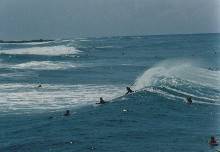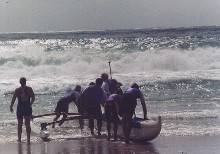Ocean Culture - People and the Sea
Activity 4: Glimpses of our Coastal and Marine environments at Seaweek
|
You may know and love your own coastal and marine patch, where you live or when you visit the beach but have you ever wondered what else is going on around our massive island coastline. Here is a glimpse of the Australian marine scene in March as seen by Alan Reid and others (acknowledged individially).
For more information on What is happening in the natural world each month and Alan Reid's Timelimes project, visit the Gould League website |
| Email us with your glimpses of the coast during Seaweek. |
|
Northern Beaches and Mangroves
Seedlings of Ceriops mangroves spear into the mud
Sea almonds Terminalia catappa on dunes grow crisp tasty nuts
The Tropical Coast - Coastal lowlands
|

Byron Bay - mid-March |
Common migrant butterflies appear in large numbers in Queensland to lay eggs on cassia
Pied imperial-pigeons leave during 2nd week
Satin flycatchers & black-faced monarchs moving north during 1st week
Many leaden flycatchers & rufous fantails arrive from south
Sacred kingfishers return
Red-browed firetails nesting in 2tn Week
Large yellow fruits of native gardenia Randia fitzalini are falling
Helmeted friarbirds return
Spangled drongoes & dollarbirds are migrating north
Cairns - wet season, mid-March
Flying foxes are up and about long before dark, drawn out by flowering melaleuca trees - their faviourite food, can be seen streaming out of their mangrove roosts across the mudflats around dusk Lots of butterflies about on the coasta and islands - especially Cairns birdwings (in all stages), perhaps due to extra foliage on caterpillar foodplants following the wet season. Bee-eaters and other birds migrating. Newly-born brush turkeys and orange-footed scrubfowl emerging from mounds - many seen on continental islands offshore.
Young black-necked storks (Jabirus) leaving the nest. Mangrove heron nesting, often in mangroves. Kwila, or Qld teak, flowering on the beaches. Kuranda quandong shedding fruit - hard nuts with tasty kernels, eaten by white-tailed rats in rainforest clad islands. Moth (Daintree) orchid flowering from March to August - white flowers. Guttarda bush flowering on beaches at night. Daintree penda may fruit heavily, producing carpets of seedlings. Box fruit trees flowering along the beaches at night and falling in morning - up to 200 x 10cm long stamens in white to pink.
Fire vine fruiting - red filigreed disc with shiny black seed, the size of a match-head, in the middle. Sassafras trees fruiting - woody capsule which splits into numerous plumed fruit, each with single seed, designed to be wind distributed. Red wattle blooming on coast and Tablelands. Crocodiles hauling themselves out of the water more frequently from now on to bask in the sun in wetlands, esturies and along the coasts.
Box jellies still around in coastal waters, swimmers must swim only within stinger nets Skies alternate between brilliant blue and blankets of low grey clouds, days are hot, humid, sticky. The one cylone of the wet season so far passed over Cairns without anyone noticing....
compiled by Stella Martin and Julie Swartz QPWS
Tropical Coast
Pink & white flowers on box-fruit mangrove attract small blossom bates and hawk moths
Fire vine fruits now maturing in rainforest - shining starlings eat red arils not seeds
Sassafras trees & red wattle reach full boom
Queensland teak or Kwila tree has bright pink flowers along beach fronts
Kuranda quandong now has mature fruit in Daintree - white-tailed rat & feral pigs feed on fallen fruit
Crocodiles are sun baking
Torresian imperial pigeon & white-tailed kingfisher leave for New Guinea
Chicks of mangrove heron hatching - crocodiles are looking to eat those on lower branches
White flowers of guttarda bush heavy with scent
Moth orchids in Daintree have white flowers
Somers in Westernport Bay Victoria
Banjo shark in shallows
Whistling kites by beach
Luminous fungi on banksia logs
Octopus egg masses washing up
Seaweek crabs amongst seaweed
Whistling kites circling above
Swifts circling low, drifting west
Meadow argus butterfly seen
Cunningham skinks by dune pool
Rufous fantail & leaden flycatcher in gully
Juvenile yellow robins seen
Orange bracket fungi on teatree
Silver xenica butterflies appear
Speckled footman moths in long grass
Sea hares washing up
Australian hobby sighted
Growling grass frogs by lawn
Young sea-squirts o sea-nymph stems washed up
Angel wing shell on high tide line
Sunshine Coast QLD
Many fungi species on rainforest logs
Mountain brushtail possums start breeding
Shorebirds & waders flock prior to migration
Spectacular veiled Dictyphora fungi emerge
Noisy Pittas feed on gait rainforest snails
Nelson Bay NSW
Fairy penguins come ashore to moult
Blackberreis are ripening
Earthworms breeding
Kangaroo apple in berry
Bandicoot babies out of pouch
European wasps around water
Brushtail possums have first litter
Conesticks & gymea lilies flower
Fruit bats mating
Octopuses lay eggs
Double-banded plover arrive from NZ
Puffball fungi appearing
Bees attracted to male casuarina spikes
White-throated needletails leave on migration
|
Byron Bay NSW
Wet season storms and high rainfall combine with full moon (spring) tides
Some great surfing and amazing ocean watching
Regional flooding
Very strong long shore drift
Beaches eroded and ocean dirty and full of soil etc washed out of the rivers after flooding
Last sightings of Leopard sharks
Sea warm and many tropical fish over small reefs
Plenty of turtle sightings, one with no front flippers
Compiled by Barbara Jensen
|

Byron Bay - mid-March |
Henley Beach, South Australia
small wave action
cooler mornings, shorter days
sand crabs washed up
brown algae in water
big tidal movement - quite low tides
a few sausage jellies around
water still about 20C
sand level is very low - more sand is needed
lots of seagulls
a young Pacific gull
no dolphins
a crested tern
a colonial ascidian washed up
a few ulva(sea lettuce)
a small rat in the rocks yesterday
OUR GULF NEEDS HELP!!!!
Compiled by Tim Hoile
Seasonal Change in the Territory
Top End
January - March The main part of the Wet
· The north-west monsoon brings heavy rains
· Tides are higher than usual
· Waterlily seeds germinate
· Saltwater crocodiles move upstream to breed
· Frogs become very vocal with the abundance of rain
· Frill-necked lizards and goannas are active
· Jabirus, Magpie Geese, Burdekin Ducks and other waterfowl lay their eggs
· Box jellyfish are prevalent in our marine waters
· The Apple Gum, Bloodwood and Sand Palm are in flower
· The Green Plum and Cocky Apple fruits become ripe
March - April The Last part of the Wet
· Heavy rains are less frequent
· Green ants are busy making nests
· Northern Snapping turtle lays her eggs
· Adult barramundi move from the mangroves to the tidal reaches of the creeks and estuaries
· Waterlilies flowers
· At the very end of the Wet the wind changes to a prevailing south-easterly, the main dry season wind. Dragonflies become abundant and Rainbow Bee-eaters migrating from southern Australia become very common.
Alice Springs
· This is still a warm time, temperatures will start to cool in April
· Red-tailed black cockatoos are seen in the eucalypts
· River Red Gums and Coolibahs are now seeding and attracting many birds
· Rainbow Bee-eaters are preparing to fly North
· Ironwoods and Bloodwoods flower at this time
· The Long -leafed Corkwoods come into bud
· The leaves of many gums show lots of evidence of skeletoniser caterpillars
Compiled by Roana O'Neill
|